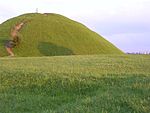Kraków Płaszów railway station
Buildings and structures in KrakówPolish railway station stubsRailway stations in Lesser Poland VoivodeshipRailway stations served by Przewozy Regionalne InterRegio

Kraków Płaszów railway station is a railway station in Płaszów, a suburb of Kraków (Lesser Poland), Poland. As of 2022, it is served by Koleje Małopolskie (KMŁ),Polregio, and PKP Intercity (EIP, InterCity, and TLK services). The station is located near Kraków-Płaszów concentration camp. The station is about 4.5 km southeast of Kraków Główny (Main) station.
Excerpt from the Wikipedia article Kraków Płaszów railway station (License: CC BY-SA 3.0, Authors, Images).Kraków Płaszów railway station
Plac Braci Dudzińskich, Krakow Podgórze
Geographical coordinates (GPS) Address Nearby Places Show on map
Geographical coordinates (GPS)
| Latitude | Longitude |
|---|---|
| N 50.03473 ° | E 19.9723325 ° |
Address
Plac Braci Dudzińskich
Plac Braci Dudzińskich
30-556 Krakow, Podgórze
Lesser Poland Voivodeship, Poland
Open on Google Maps










